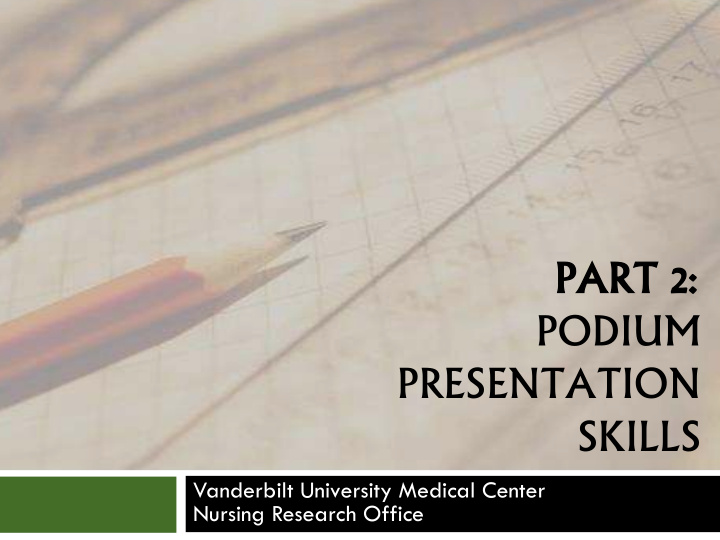



PA PART T 2: 2: PODIUM PRESENTATION SKILLS Vanderbilt University Medical Center Nursing Research Office
Objective The objective of this presentation is to prepare you for a successful presentation.
Time Limit If you are given a time limit for your presentation it is important not to deviate from your script. On average you will spend 1 minute discussing each slide.
Not Using PowerPoint Be more deliberate with the transition of topics Have notes with you that might include: • Key points you want to make • Discussion questions • Handouts for audience
Practice Practice by yourself in front of a mirror Practice in front of an audience: • Schedule a block of time that is twice as long as the scheduled presentation • Tape record your presentation • Invite co-workers that are and are not familiar with the topic.
Tips for a Successful Presentation Know your material Podium panic Eye contact Security items Body language Questions & answers Voice
Tips: Know your Material Speech should come across as a conversation Do not memorize material Do not read your slides word for word
Know your Material - Graphics Be sure to orient people to your graphics • What does each color represent • Clearly state what the axes represent • Describe how the graphic fits into your presentation
Tips: Eye Contact It is important to have eye contact with your audience at all times. • Pick out a friendly face and keep them as a focal point. • If in a large auditorium, you will need several “friendly” faces.
Tips: Body Language Do’s Do Not’s Make eye contact Chew gum/candy Professional stance, Bite your fingernails Click or tap pen or with your hands out of pockets and arms pencil Play with clothing relaxed pieces Shuffle notes
Tips: Voice Articulate clearly Speak slowly Vocalize pauses and punctuation Speak loudly
Tips: Podium Panic For some speakers presentations can make them extremely nervous. To combat podium panic keep these tips in mind: o Audiences are forgiving o Nervousness is usually o Be prepared not visible to the o Practice audience o Be yourself o Avoid caffeine/other o Deep breathing stimulants before presentation
Tips: Security Items Print out a copy of your slides and take with you to the podium Have multiple copies of your presentation (e.g. email it to your self, jump drive) Bring your own clicker (to advance slides) in case one is not provided.
Tips: Questions & Answers At the end of your presentation leave time for questions and answers. • Do not argue with members of the audience • Be honest • Keep answers brief • It is ok not to know the answer
Day of Presentation Pick out clothes that look professional and make you feel comfortable. Check equipment before the presentation starts. Practice relaxation techniques (i.e. breathing or muscle relaxation) before you approach the podium.
Next Steps If you need assistance with your PowerPoint slides or the outline of your presentation we can help: Nursing Research Office S-2413 MCN 3.2992 www.VanderbiltNursingEBP.com
References 1) Houser, J. (2012). Communicating Research Findings, In Nursing Research: Reading, Using, and Creating Evidence (2 nd ed.) . Sudbury, MA. 2) Zerwic, J.J., Grandfield, K., Kavanaugh, K. et al. Tips for Better Visual Elements in Poster and Podium Presentations. Educ Health (Abingdon), 23(2), 267. 3) Houser, J. (2006). Presenting Your Research Effectively, In Clinical Research in Practice: A Guide for the Bedside Scientist . Sudbury, MA.
Recommend
More recommend